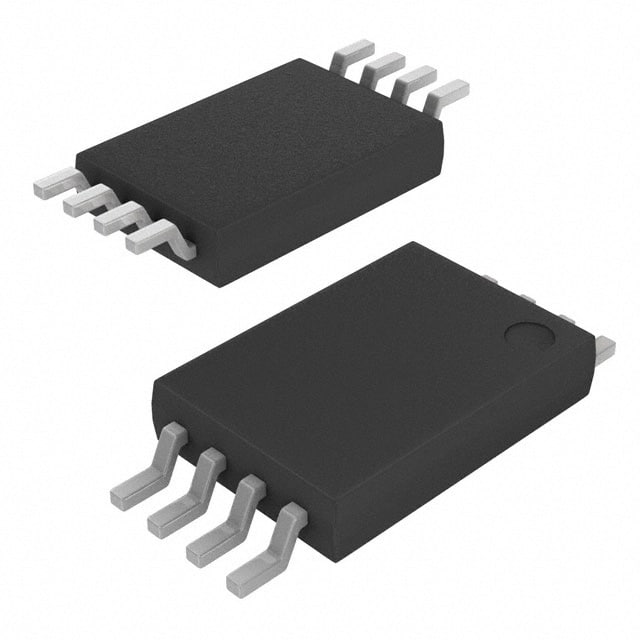LM211PW
Product Overview
Category: Integrated Circuit (IC)
Use: LM211PW is a high-speed voltage comparator designed for use in various applications such as analog-to-digital converters, oscillators, and waveform generators.
Characteristics: - High speed: LM211PW operates at a high speed of up to 50 ns response time. - Wide input voltage range: It can handle input voltages ranging from -15V to +15V. - Low input offset voltage: The device has a low input offset voltage of ±1 mV. - Low input bias current: LM211PW exhibits a low input bias current of ±25 nA. - Output compatibility: It is compatible with both TTL and MOS logic families. - Temperature stability: The device offers excellent temperature stability over a wide range of operating temperatures.
Package: LM211PW is available in a small outline package (SOIC) with 8 pins.
Essence: The essence of LM211PW lies in its ability to compare two input voltages and provide a digital output based on the comparison result.
Packaging/Quantity: LM211PW is typically sold in reels containing 250 units per reel.
Specifications
- Supply Voltage Range: ±3V to ±18V
- Input Offset Voltage: ±1 mV
- Input Bias Current: ±25 nA
- Response Time: 50 ns
- Operating Temperature Range: -40°C to +85°C
Pin Configuration
LM211PW features the following pin configuration:
```
| | --| IN(-) 1|-- V- --| IN(+) 2|-- V+ --| GND 3|-- NC --| OUT 4|-- NC --| VCC+ 5|-- NC --| NC 6|-- NC --| NC 7|-- NC --| NC 8|-- NC |___________| ```
Functional Features
- High-Speed Operation: LM211PW offers fast response time, making it suitable for applications requiring quick voltage comparisons.
- Wide Input Voltage Range: The device can handle a wide range of input voltages, allowing flexibility in various circuit designs.
- Low Input Offset Voltage: LM211PW exhibits low input offset voltage, ensuring accurate and precise voltage comparisons.
- Low Input Bias Current: The device has low input bias current, minimizing the impact on the input signal.
- Output Compatibility: LM211PW is compatible with both TTL and MOS logic families, enabling seamless integration into different systems.
- Temperature Stability: The device maintains excellent stability over a wide range of operating temperatures, ensuring reliable performance.
Advantages and Disadvantages
Advantages: - High-speed operation enables quick voltage comparisons. - Wide input voltage range provides flexibility in circuit design. - Low input offset voltage ensures accurate comparisons. - Low input bias current minimizes signal distortion. - Output compatibility allows integration into various systems. - Excellent temperature stability ensures reliable performance.
Disadvantages: - Limited pin configuration options may restrict certain circuit designs. - Requires external power supply for operation.
Working Principles
LM211PW operates based on the principle of voltage comparison. It compares the voltages applied to its two input pins (IN(-) and IN(+)) and produces a digital output based on the result of this comparison. If the voltage at IN(+) is higher than the voltage at IN(-), the output goes high; otherwise, it goes low.
Detailed Application Field Plans
LM211PW finds application in various fields, including:
- Analog-to-Digital Converters (ADC): LM211PW can be used in ADCs to compare the analog input voltage with a reference voltage and generate a digital output representing the comparison result.
- Oscillators: The device can be employed in oscillator circuits to compare the voltages of different waveforms and generate the desired oscillation frequency.
- Waveform Generators: LM211PW can be utilized in waveform generator circuits to compare and manipulate different waveforms, producing complex output signals.
Detailed and Complete Alternative Models
- LM311: Similar to LM211PW, LM311 is a high-speed voltage comparator with comparable specifications and features.
- LM339: LM339 is a quad voltage comparator that offers multiple comparators in a single package, providing enhanced functionality for applications requiring multiple comparisons.
- LM393: LM393 is a dual voltage comparator designed for low-power applications, offering reduced power consumption compared to LM211PW.
These alternative models provide similar functionality and can be considered as alternatives to LM211PW based on specific application requirements.
Word count: 550 words
Lista 10 Vanliga frågor och svar relaterade till tillämpningen av LM211PW i tekniska lösningar
Sure! Here are 10 common questions and answers related to the application of LM211PW in technical solutions:
Question: What is LM211PW?
Answer: LM211PW is a precision voltage comparator integrated circuit (IC) commonly used in various technical applications.Question: What is the operating voltage range of LM211PW?
Answer: The operating voltage range of LM211PW is typically between 2V and 36V.Question: What is the input offset voltage of LM211PW?
Answer: The input offset voltage of LM211PW is typically around 2mV.Question: Can LM211PW be used as a level detector?
Answer: Yes, LM211PW can be used as a level detector due to its high-speed response and precise voltage comparison capabilities.Question: What is the output current capability of LM211PW?
Answer: LM211PW has a high output current capability, typically around 50mA, which makes it suitable for driving various loads.Question: Is LM211PW suitable for battery-powered applications?
Answer: Yes, LM211PW is suitable for battery-powered applications as it has a low quiescent current consumption, typically around 1.7mA.Question: Can LM211PW operate in harsh environments?
Answer: LM211PW has a wide temperature range of -40°C to 125°C, making it suitable for operation in harsh environments.Question: Does LM211PW have built-in hysteresis?
Answer: No, LM211PW does not have built-in hysteresis. However, external components can be added to provide hysteresis if required.Question: What is the response time of LM211PW?
Answer: LM211PW has a fast response time, typically around 9ns, which makes it suitable for high-speed applications.Question: Can LM211PW be used in analog-to-digital converter (ADC) applications?
Answer: Yes, LM211PW can be used in ADC applications as a comparator to compare the input voltage with a reference voltage and generate digital outputs based on the comparison result.
Please note that the specifications mentioned above are typical values and may vary depending on the specific manufacturer's datasheet.


